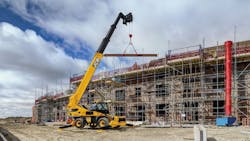Rotating Telehandlers Look to Turn Heads
More on construction lifting
- Remotes aid rotating telehandlers.
- IPAF adds two MEWP training options.
- Five years after ANSI A92, an update.
- IPAF targets MEWP overturns.
- Best safety practices for telehandlers.
Key takeaways|
- How rotating telehandlers differ from traditional
- Safety benefits of rotating telehandlers
- Rotating telehandlers availabile in North America
Equipment trends coming from Europe to North America have been a mixed bag.
Remember when we heard wheeled excavators and compact wheel loaders would one day be everywhere thanks to urbanization? Though OEMs offer more models of both categories here than they ever have, that hasn’t exactly happened.
On the other hand, tiltrotators, now ubiquitous on excavators in Europe, show promise and may end up being more than a niche product in North America.
The jury is still out on the rotating telescopic handler. Brought here from Europe by Manitou, there are now a handful of OEMs offering models, including JLG, JCB, and Italy’s Magni.
Manitou thinks the rotating telehandler’s day is coming. “Greater rotating telehandler adoption will be driven by a number of industry trends and shifts in how job sites work,” says Steve Kiskunas, product manager for telescopic material handlers, Manitou.
JLG agreed in its examination of access equipment trends for 2025.
“As construction projects demand more productivity with fewer resources, access equipment manufacturers will continue to develop high-efficiency machines that require less power while offering greater lift height, capacity, and reach,” says Brent Miller, JLG’s VP for sales administration, marketing & Latin America. “Machines with greater versatility, such as the ability to handle multiple tasks such as lifting, material handling, or platform rotation, will become more common to help reduce costs and improve productivity.”
How rotating telehanders differ from traditional telehandlers
Rotating telehandlers offer from 200 degrees of swing on either side to 360 degrees of swing from a stationary position. Traditional telehandlers must be moved to achieve such wide material handling/lift-and-place coverage.
“The answer largely comes down to capacities: lifting height, reach, and lifting capacity,” Kiskunas says. “Our largest construction telehandler, the Manitou MTA 12055, offers a maximum lifting capacity of 12,000 pounds and a maximum lifting height of just over 55 feet—as well as a maximum forward reach of 40 feet 9 inches.
“By way of comparison, the largest Manitou rotating telehandler features lifting heights and maximum outreach [113 feet 10 inches and 91 feet 10 inches, respectively] more than twice that of the largest traditional telehandler, as well as a higher maximum capacity of 15,432 pounds,” Kiskunas says.
How safe are rotating telehandlers?
The question naturally arises, what are the differences involving load charts versus conventional telehandlers?
“The load chart experience with rotating telehandlers versus most conventional telehandlers is quite different and more advanced,” Kiskunas says. “While yes, rotating telehandlers do have the traditional printed load charts available, they are also loaded electronically into the machine and its operating interface to provide intelligent, real-time guidance and overload prevention for the operator.
“We take it a step further with the attachment recognition system that automatically identifies the attachment equipped on the machine, and adjusts the load chart accordingly based on the type and weight of the attachment,” Kiskunas explains. “That intelligent, real-time load chart guidance based on the weight of the attachment and the weight of the load gives the operator the greatest opportunity to operate that machine within the suggested parameters throughout the lift cycle. Warnings are then delivered to the operator as they approach unsafe or unrecommended conditions, and actually restricts the operator from making movements that would put the machine and the job site in an unsafe condition.”
Kiskunas also says job sites are more cramped than ever before, and safety is an important factor.
“The consistent movement of equipment creates ‘opportunities for exposure’ for that equipment to hit other equipment, infrastructure on the site, or other workers,” he says. “Traditional telehandlers, skid steers, and other equipment built for transferring palletized goods around site all require the machine to be mobile to move their materials from position to position. The same goes for scissor lifts and other working platforms.
“There’s also a movement to minimize traffic on job sites for site disturbance purposes,” Kiskunas says. “This could be for reasons as simple as not tracking mud onto the road in a residential neighborhood, a desire to minimize site rework, or to avoid disturbing underground utilities on job sites where that site infrastructure already exists.”
The clearest benefit for most rotating telehandlers is that the machine can be put in one position to rotate and lift, reach, and place.
Rotating telehandlers offer versatility
For managers and rental companies looking to maximize utilization, rotating telehandlers by their nature have the ability to stay busy.
“Like the backhoe, or other multiuse machines, a rotating telehandler is actually three machines in one: a telescopic telehandler, a work platform, and a winch with jib,” Kiskunas says. “Having all these capabilities in a single machine may alleviate the need to own numerous machines that do separate things, or at least have fewer machines on site to minimize traffic and clutter.”
Much like skid steers and CTLs, there are many attachments available for these machines, from work platforms and jibs to concrete mixing buckets and swing fork carriages. Manufacturers are so serious about attachments for rotating telehandlers that some, like JLG and Manitou, have attachment recognition systems similar to those on skid steers, CTLs, and loaders.
“We have an attachment recognition system within the machine that automatically assigns the appropriate lifting charts and attachment information into the monitor to best inform the operator about the operating characteristics of the machine,” Kiskunas says.
Who makes rotating telehandlers?
As for manufacturers, Magni fields a whopping 20 rotating telehandlers, with lifting heights from 57 to 167 feet, and lifting capacities from 11,000 to 28,600 pounds. They feature a patented load control system that detects the risks of overload during use and inhibits further aggravating movements.
Liebherr supplies some Magni models with the slewing drive for stability, fluidity, and control in lifting operations.
JLG has three rotating telehandler models, all with 13,200-pound lift capacities. They range from a 67-foot maximum lift height and 59-foot 6-inch maximum reach to a 97-foot maximum lift height and 86-foot maximum reach.
JCB offers one model in North America, the Loadall 512-83R. It has an 83-foot maximum lift height and a maximum reach of 70 feet 2 inches. Maximum lifting capacity is 12,125 pounds. Its overall weight is 42,770 pounds. Capacity at max reach is 660 pounds.
Manitou has 11 rotating telehandler models available in North America. As with other machine categories, rotating telehandlers are beginning to offer a choice of power. Traditional diesel machines are available, as are some engineered to save fuel and cut emissions.
“Manitou manufactures both low emissions all-electric versions of select models, as well as a hybrid model of each that includes an onboard diesel engine ‘range extender’ that ensures the machine is operational under diesel power even if away from a charging station,” Kiskunas says.
“That range extender then also serves to recharge the battery as it operates, giving the operator the best of both worlds.”
About the Author
Frank Raczon
Raczon’s writing career spans nearly 25 years, including magazine publishing and public relations work with some of the industry’s major equipment manufacturers. He has won numerous awards in his career, including nods from the Construction Writers Association, the Association of Equipment Manufacturers, and BtoB magazine. He is responsible for the magazine's Buying Files.



